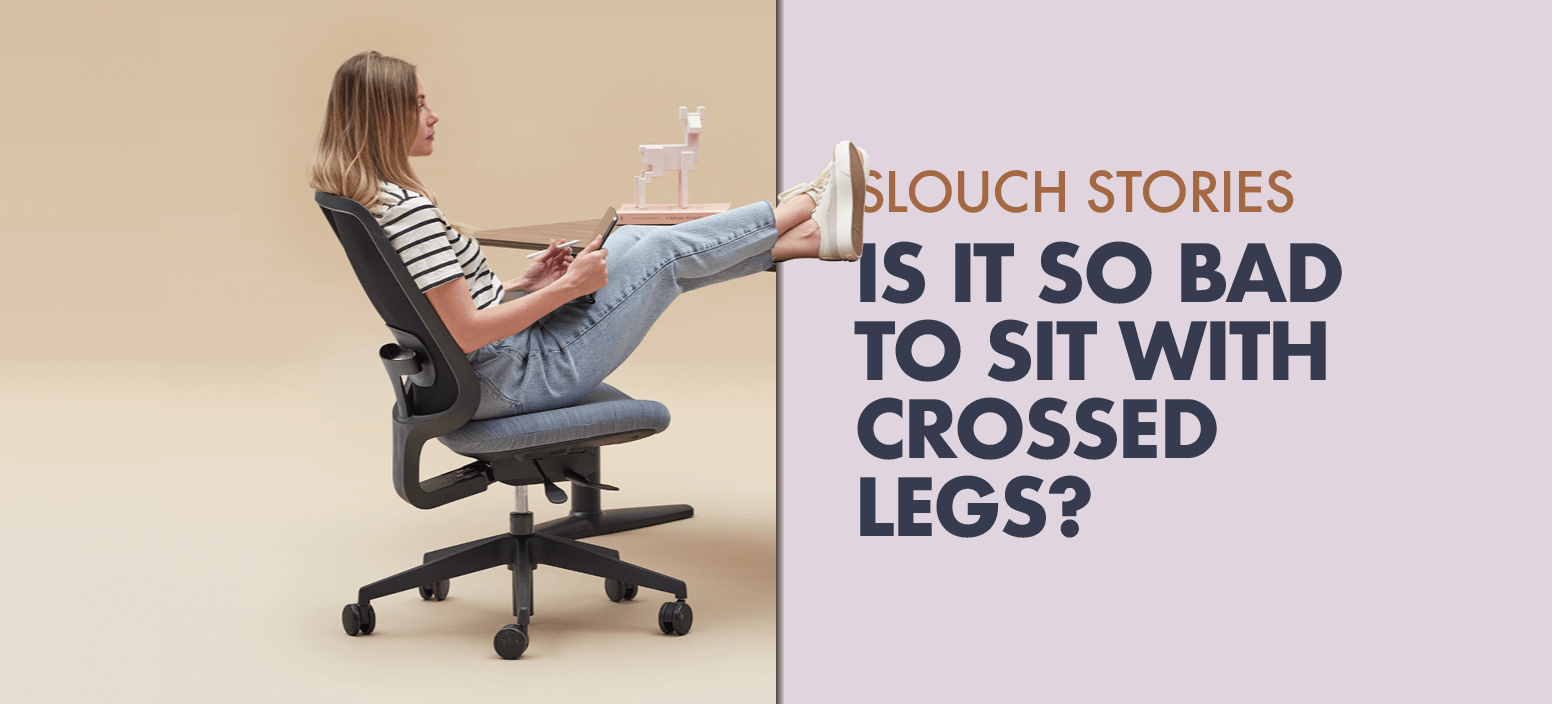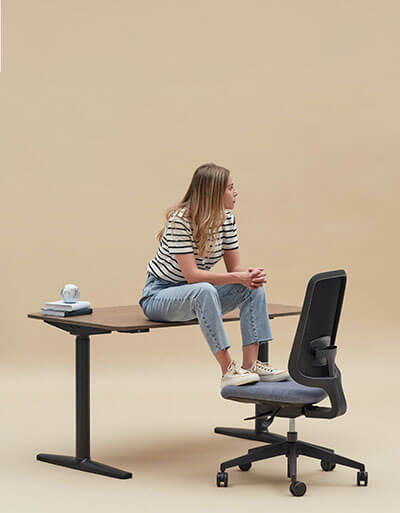Is sitting cross-legged bad or is it just a myth? Slouch is here to get the answers.
Stop. Take a look at how you’re sitting right now. Are you sitting cross-legged on your office chair? The odds are high that you are
Given that it’s such a popular way to sit and so many of us spend such a high proportion of our lives at our home office desks, it’s well worth investigating: is sitting cross-legged bad for your health?
As proponents for ergonomic office furniture that’s as kind to your joints as possible, we’re here to answer your questions.
So, is sitting cross-legged really bad for you?
Unfortunately, yes. Sitting cross-legged has been shown to have a host of negative short and long-term health effects on the body. While it might feel more comfortable, it’s actually doing you no favours.
Why does it feel comfortable to sit cross-legged in a chair if it’s so bad for you?
Most people only cross their legs because it mechanically pulls their back up against the back of their chair. The tension of the crossed-over legs provides a more stable base to rest against and that allows your muscles to relax. Because the more supported you are, the more relaxed your muscles can be.
Here’s the good news. We’ve got a great alternative – an ergonomic office chair that supports your back properly.
Potential negative effects of sitting cross-legged
Here’s the deal. Sitting cross-legged in chairs is proven to cause:
- Blood flow constriction – Clamping the weight of one leg over the other constricts major veins in the leg, preventing freshly oxygenated blood from properly circulating in the body.
- Peroneal nerve compression – The peroneal nerve is a branch of the sciatic nerve. It runs down from your hip, supplying sensation to your feet, toes and lower leg. Compressing it by sitting cross-legged is shown to cause peroneal nerve dysfunction. This can cause tingling, numbness, pain and even foot drop. Scary stuff.
- Increased blood pressure – The Journal of Clinical Nursing found that sitting cross-legged at the knee results in a ‘significant increase’ in blood pressure. They directly recommend sitting with feet flat on the floor.
- Hip pain – Sitting with your legs crossed for extended periods puts your pelvis in a tilted position, in turn putting pressure on your hip joints. If you get nagging hip pain after sitting cross-legged at an office chair all day – this is why.
Tips for a comfortable sit
It’s not all doom and gloom. Thankfully there are ways that you can beat the pesky habit of sitting cross-legged on chairs, especially in the office.
The reality is, most office workers will need to sit for a good proportion of their day. So let’s get into the best ways to make your sit comfortable and as ergonomic for your body as possible.
Choose an ergonomic office chair
Our engineers have been hard at work, packing as many ergonomic features into our home office chairs as possible, to ensure you achieve the best possible workplace ergonomics.
You see, the real key to stop sitting cross-legged in chairs is to not need to. Our chairs are jam-packed with features that make them conform excellently to your body, for a personalised sit. Here’s what you can expect:
- 55mm of adjustable lumbar support to get back support exactly where you need it
- Adjustable seat depth, height and back tilt tension to keep you at the optimal distance from your desk and screen
- A comfortable, moulded foam seat pad just like the material that’s used in car seats, that will provide minimal sinking or warping
Once you start using our specially optimised task chairs, you can break the habit of sitting cross-legged on chairs and start reaping the benefits that ergonomics aims to achieve.
Alternate legs
We know it’s hard to break a habit if you’re used to it. While you’re getting used to a new type of office chair that supports your body more fully, try to catch yourself when you cross your legs and instead put your feet flat against the floor. At the very least, swap which leg you’re crossing over to avoid intense compression.
Ensure your desk is set up correctly for your body
Your chair isn’t entirely to blame if you’re sitting cross-legged. Part of the problem is that if you’re not sitting comfortably it might be because you’re straining to use your computer properly or slouching over your desk. Here’s how to make sure your desk is set up for success:
- Ensure you have enough space to work on so that your arms aren’t cramped. We cover this in our guide about desk depth.
- Make sure you’re working at the ideal desk height for you.
The problem isn’t just sitting leg-crossing – it’s sitting full stop
What’s clear is that sitting in the same position for extended periods of time just isn’t a good idea for your body. For instance, research on sedentary call centre workers proved a clear link that sitting in a static position for prolonged periods of time directly correlated to lower back pain.
You can mitigate this by taking the steps above to ensure a more ergonomic sit, but really the best thing you can do is reduce the time you sit for. Let’s discuss how.
Tips for combatting prolonged sitting:
Use a standing desk: Wondering are standing desks worth it? Here’s food for thought. In 2014 Denmark made it compulsory for employers to offer workers sit-stand desks. Estimates vary but tend to put sit-stand desk usage in the Nordic countries at somewhere near 80-90%. That’s a compelling uptake rate.
Browse our range of standing desks to see what the hype is about and potentially reap the many benefits of them.
Take regular breaks: Working ceaselessly in the same position for hours at a time isn’t just bad for your body – it also impacts your mind poorly. Regular breaks are key to triggering your motivation cycle and keeping you happy, energised and productive. So get up and take the break you’ve been promising yourself.
Move your body with desk exercises: Even the smallest movements can help keep your blood circulating. Try adding in some hip tilts and ankle rolls throughout the day so that you aren’t completely static in your chair.
Meet Slouch Your ergonomic office partner
We know this is a lot to take in. If there’s one clear message you take away from this guide it’s this: you deserve to be comfortable at work. It’s our business’s entire raison d’être. Investing in supportive office furniture is an investment in your own health and well-being.
So put yourself first for once and explore the chairs and desks our product designers have worked hard to make ergonomic.
Fill out this contact form if you have queries about our products and we’ll get back to you. For general enquiries, email us at [email protected] and our experts will be in touch to assist.
Additional reading:

